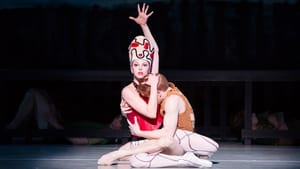Stay in the Loop
BSR publishes on a weekly schedule, with an email newsletter every Wednesday and Thursday morning. There’s no paywall, and subscribing is always free.
Loving the prodigal
Prokofiev’s 'Prodigal Son' at the Pennsylvania Ballet (second review)

Three Pennsylvania Ballet works share movements, but only one tells a story.
Two of the works on their midwinter program were abstract pieces by living choreographers and the third was a story ballet by George Balanchine, who died in 1983. The abstract works, Polyphonia (2001) by Christopher Wheeldon and Shift to Minor (world premiere) by the company’s choreographer in residence, Matthew Neenan, benefited from beautiful music.
Indeed, individual musicians received their own well-deserved ovations at the February 7 matinee: veteran Martha Koeneman for handling Polyphonia’s ten disparate piano pieces by György Ligeti and violinist Luigi Mazzocchi for his featured playing in Wolfgang Amadeus Mozart’s Violin Concerto No. 5 in A major, K 219, the foundation for Neenan’s newest dance.
These abstract ballets proved fitting lead-ins to Balanchine’s Prodigal Son, which was derived from the well-known parable in Luke’s gospel and choreographed in 1929 for Serge Diaghilev’s Ballets Russes. The intertwining bodies in Polyphonia and shaking fists in Shift to Minor foreshadowed similar movements in Balanchine’s work. Such movements in a story ballet, however, do more than express the music, suggest an idea, or set a tone — they help to advance the tale.
Telling gestures
The closely wrapped bodies of the Prodigal (Etienne Diaz) and the Siren (Lillian Di Piazza), for example, represent their lusty union, while the Prodigal’s fist-shaking in the opening scene signals his incipient rebellion. Near the end of that scene, the Prodigal and his father (James Ihde) stand at opposite sides of the stage, indicating their emotional distance. Each man raises an arm and reaches toward the direction he is facing — the son toward the audience (and away from his father’s tent) and the father toward his son. The parallel stances poignantly convey both a son’s yearning for independence and a father’s paternal love.
Balanchine (or perhaps the ballet’s librettist, Boris Kochno) increased the parable’s drama by condensing the “prostitutes” or “harlots” mentioned in the biblical text into a singular Siren, a physically and emotionally overpowering queen of seduction. The towering, long-limbed Felia Doubrovska originated the role in Paris in 1929, and later coached a worthy successor, Yvonne Mounsey, who danced the part in America. Doubrovska insisted that the Siren’s arms slither like snakes, particularly as she raises one arm skyward in triumph while clutching the Prodigal with her other arm. This has become the Siren’s signature pose. Although in the original production Doubrovska had cupped her raised hand to mimic a cobra’s head, modern dancers tend to face their palms to the audience and flay their fingers. Mounsey lamented this and other subtle changes over the years, which tend to diminish the Siren’s evil sensuality; indeed, Di Piazza’s portrayal could have used a bit more slithering.
“Awful ballet, lousy, rotten”
Although Balanchine was a devout Christian, Prodigal Son was not one of his favorite ballets. Edward Villella, who became identified with the title role at the New York City Ballet, recalled the choreographer’s eventual assessment of his own work: “Awful ballet, lousy, rotten. No good. I hate it. Old-fashioned. Terrible ballet.” Nevertheless, it was well received from the outset and is one of only two Balanchine ballets from the Diaghilev period that survive to this day, no doubt because men and women still grapple with sin, evil, and justice, and because sons continue to rebel and fathers to forgive.
For a review by Robert Zaller, click here.
What, When, Where
The Pennsylvania Ballet. Prodigal Son, choreography by George Balanchine, music by Sergei Prokofiev; Polyphonia, choreography by Christopher Wheeldon, music by György Ligeti; Shift to Minor, choreography by Matthew Neenan, music by Wolfgang Amadeus Mozart. At the Merriam Theater, 250 South Broad Street, February 5-8, 2015. 215-893-1999 or www.paballet.org.
Sign up for our newsletter
All of the week's new articles, all in one place. Sign up for the free weekly BSR newsletters, and don't miss a conversation.
 Sharon Skeel
Sharon Skeel